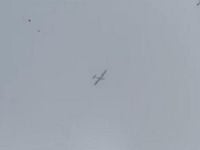On April 29, 2025, the Smolensk region faced a significant threat as authorities reported a massive drone attack on the area. The Governor of Smolensk, Vasily Anokhin, took to his official Telegram channel to inform the public about the situation, detailing how the Ministry of Defense of the Russian Federation's electronic warfare forces successfully intercepted and destroyed 15 enemy unmanned aerial vehicles (UAVs) on their approach to Smolensk.
The incident began when an unmanned aerial vehicle was discovered in a forest massif near the village of Piskarevo in the Dorogobuzhsky district. This prompted immediate action from local and military authorities. Anokhin emphasized the importance of public safety during such attacks, urging residents to avoid open spaces and windows to minimize risk during UAV incursions.
“Dear Smolensk residents, I remind you that in the event of a drone attack, it is essential to stay away from open areas, move away from windows, and avoid filming the actions of air defense forces,” Anokhin stated. He further advised citizens not to approach any debris from the UAVs and to report their locations to emergency services by calling 112.
Fortunately, according to preliminary information, there were no casualties or damage reported on the ground during this incident. This successful interception of enemy UAVs highlights the effectiveness of the region's air defense capabilities and the preparedness of local authorities to respond to threats swiftly.
The drone attack is part of a broader pattern of escalating tensions in the region, which has seen increased military activity and security measures in recent months. The Smolensk region, located in western Russia, has been strategically significant due to its proximity to the borders with Belarus and Ukraine, making it a focal point for military operations and defense initiatives.
In light of this recent attack, Anokhin's proactive communication reflects a commitment to keeping the public informed and safe. His directives to the citizens serve not only as guidance during emergencies but also as a reminder of the ongoing challenges posed by aerial threats.
The discovery of the UAV in Piskarevo and the subsequent actions taken by the Ministry of Defense underscore the critical nature of surveillance and defense strategies in the region. As tensions continue to simmer, the need for robust air defense systems becomes increasingly apparent.
This incident raises questions about the effectiveness and reliability of current defense measures against UAV threats. As technology evolves, so too do the tactics employed by adversaries, necessitating constant vigilance and adaptation from defense forces.
Local residents have expressed their concerns regarding safety, with many feeling anxious about the implications of such attacks. The governor's reassurance and the prompt response from military forces have provided some comfort, but the specter of future attacks remains a pressing concern.
As the situation develops, authorities are likely to increase their monitoring efforts and enhance public awareness campaigns to prepare citizens for any potential future incidents. The emphasis on reporting suspicious activity and remaining vigilant is crucial in maintaining community safety.
In conclusion, the events of April 29 serve as a stark reminder of the ongoing security challenges faced by the Smolensk region. With military engagements on the rise and the threat of drone attacks looming, it is essential for both authorities and residents to remain alert and prepared for any developments that may arise in the future.


